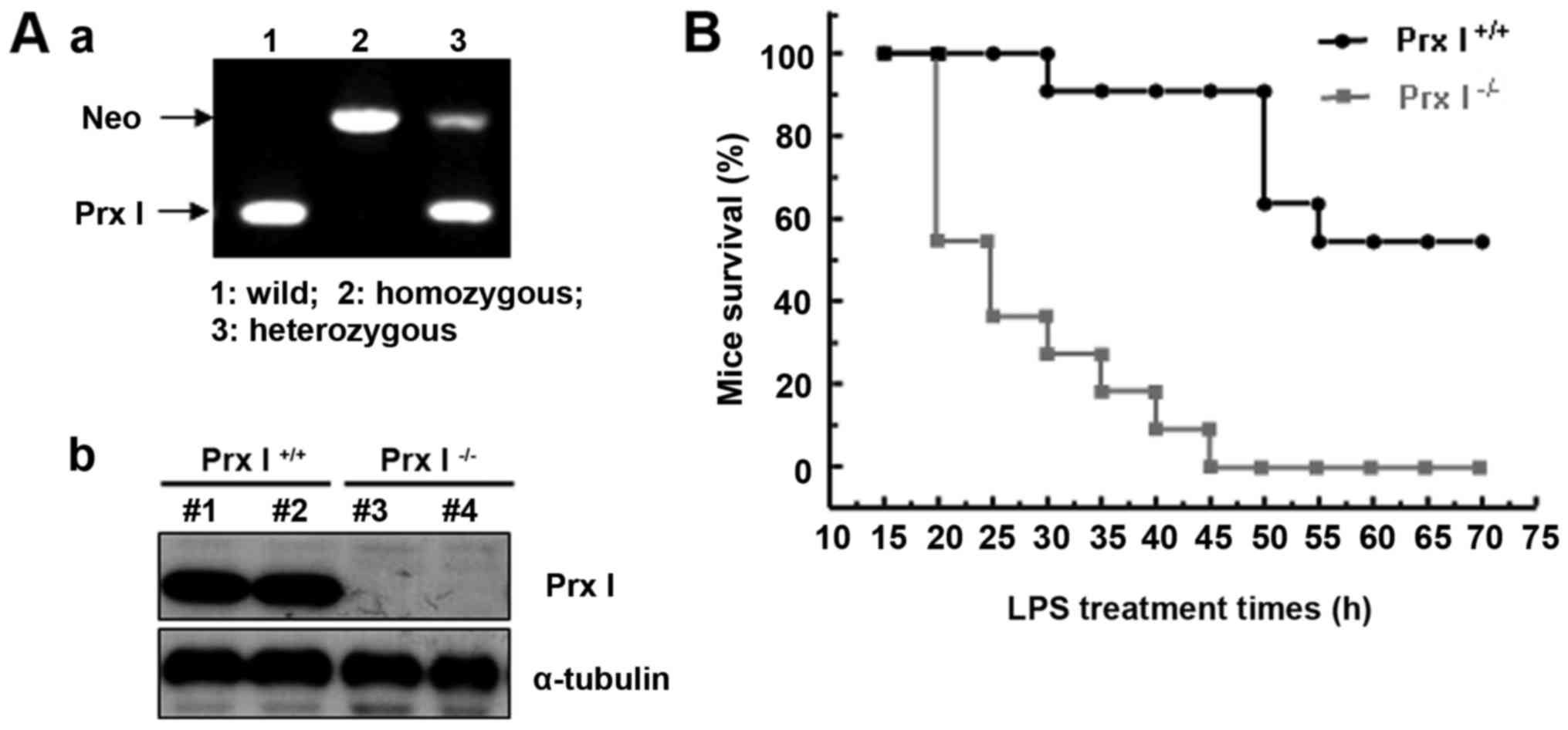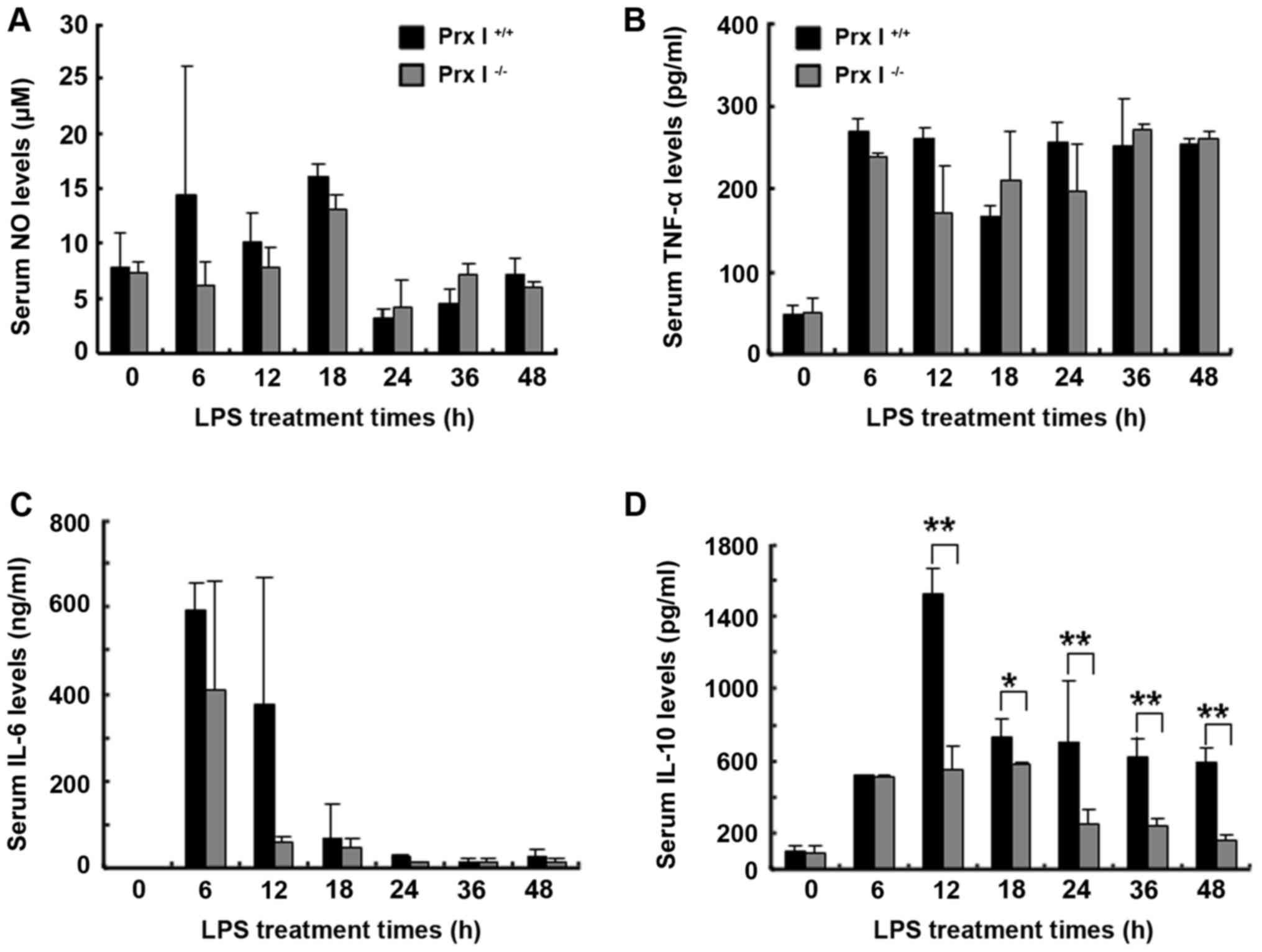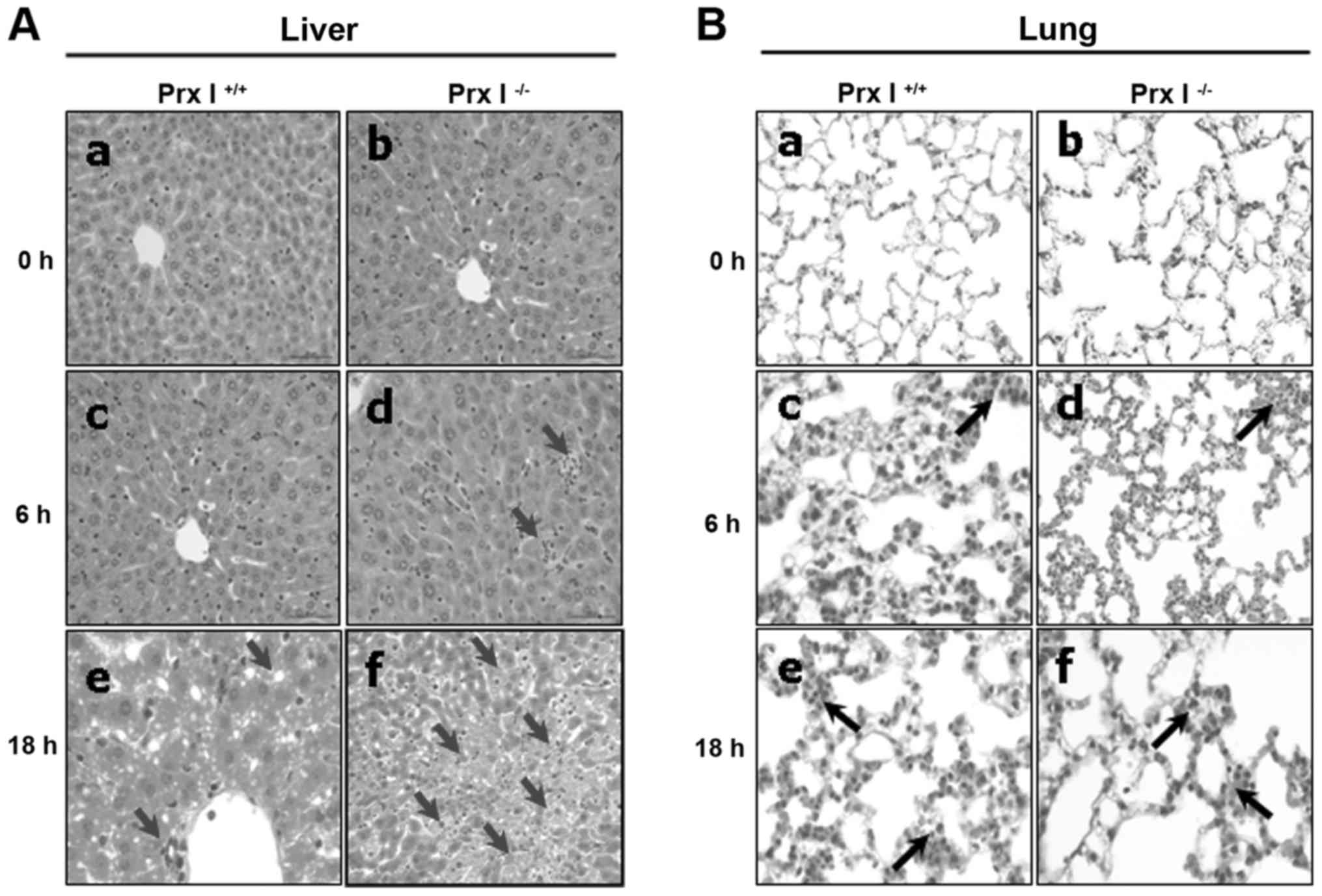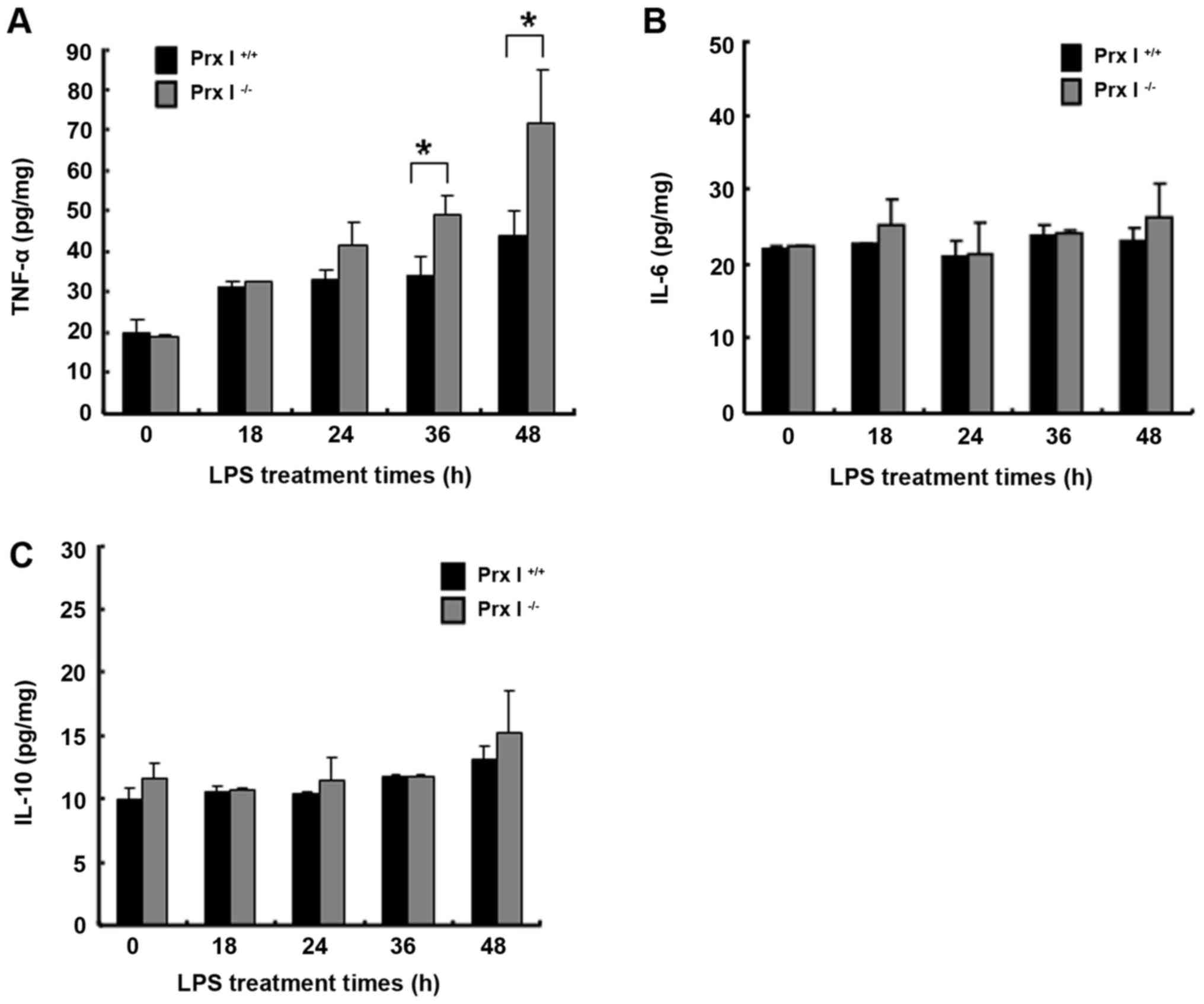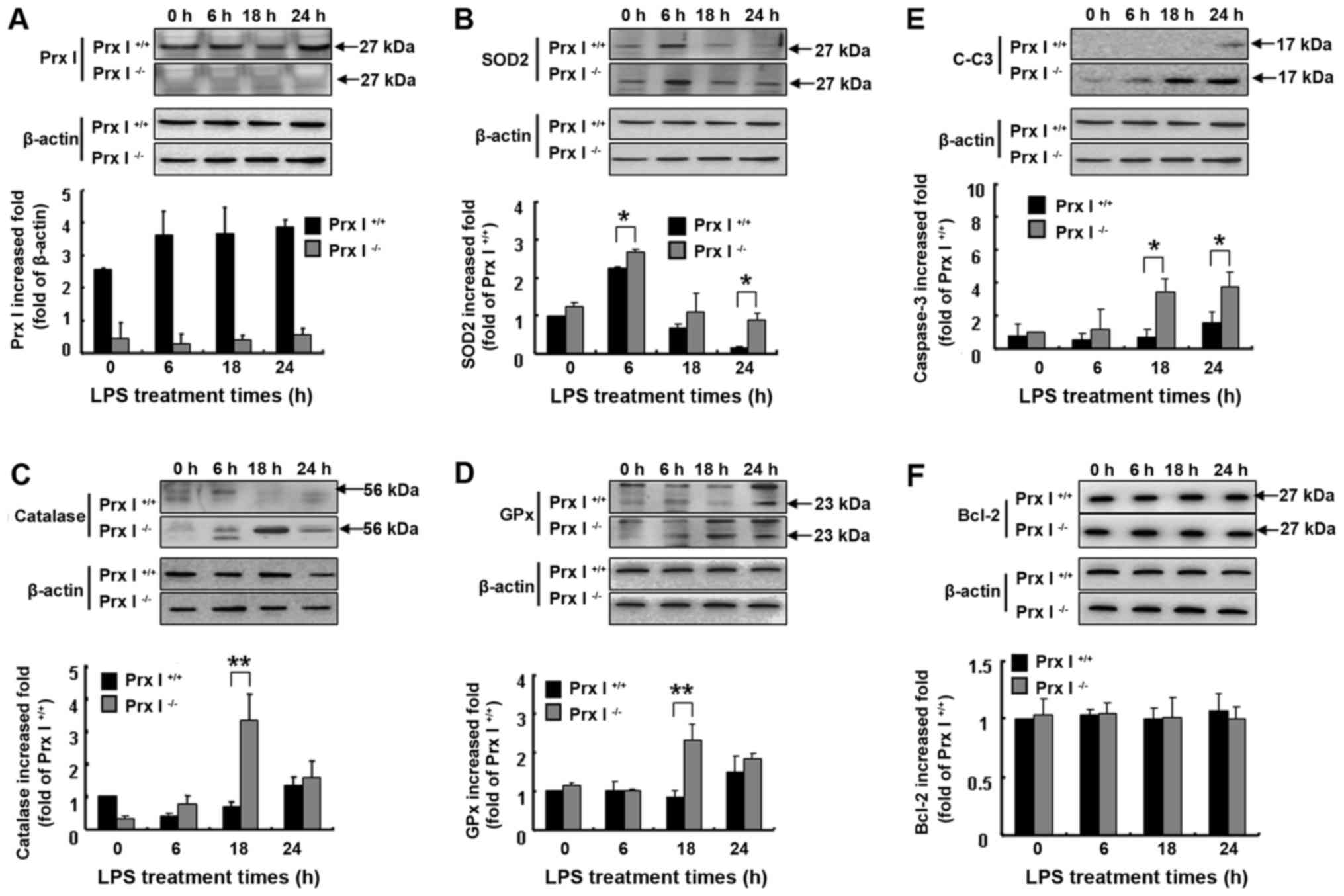Peroxiredoxin I deficiency increases LPS‑induced lethal shock in mice
- Authors:
- Published online on: June 14, 2018 https://doi.org/10.3892/mmr.2018.9170
- Pages: 2427-2432
Abstract
Introduction
Peroxiredoxins (Prxs) are antioxidant enzymes that catalyse cellular hydrogen peroxide (H2O2) production, exhibit a protective role in cells and are required for cell metabolism and redox signalling (1–3); in addition, Prxs play essential roles in neurodegenerative diseases, cancer and inflammatory processes (4).
Peroxiredoxin I (Prx I), a member of the Prx family, is a multifunctional protein originally identified as an intracellular scavenger of H2O2. Prx I has also been shown to act as a molecular chaperone with the ability to modulate the actions of numerous molecules, as a regulator of transcription, and as a signal modulator (5). Prx I knockout shortens the lifespan of erythrocytes, resulting in haemolytic anaemia with increased cellular ROS levels, protein oxidation, and Heinz body formation, and several malignant cancers in mice (6), suggesting the important role of Prx I in the defence against to oxidative stress. Recombinant Prx I can also bind to Toll-like receptor 4 (TLR4) and stimulate TLR4-dependent cytokine secretion in macrophages and dendritic cells through CD14/MD2/MyD88-dependent signalling pathways (7). Prx I knockdown can modulate the secretion of inflammatory cytokines, such as interleukin (IL)-10, IL-1β and tumour necrosis factor (TNF)-α, in lipopolysaccharide (LPS)-stimulated RAW264.7 macrophages via the STAT3 signalling pathway (8). Furthermore, our previous study revealed that Prx I deficiency attenuates the macrophage phagocytic capacity for clearing erythrocytes in the mouse response to oxidative stimulation (9). All these reports suggest the involvement of Prx I in oxidation-related inflammatory processes.
LPS has been reported to stimulate the innate immune response via recognition of the TLR4 complex and triggering the cellular signalling pathways that produce inflammatory cytokines and organic septic shock (10,11). It is well-known that intraperitoneal or intravenous injections of high LPS concentrations into animals can induce fatal septic shock and subsequently leads to tissue damage, body temperature dysregulation, and lethality. However, the regulatory effect of Prx I on LPS-stimulated mouse death is not understood.
In this study, we performed experiments to understand the protective function of Prx I on LPS-induced lethal shock in wild-type and Prx I knockout mice. Our results revealed that Prx I deficiency increased LPS-induced mouse death, with more liver damage, TNF-α tissue accumulation and oxidative stress, which was marked by higher expression levels of the antioxidant enzymes superoxide dismutase 2 (SOD2), catalase and glutathione peroxidase (GPx).
Materials and methods
Mice and genotype analysis
C57BL/6J (wild-type and Prx I knockout) pathogen-free mice were kindly provided by the laboratory of Dr. Dae-Yeul Yu, Korea Research Institute of Bioscience and Biotechnology (KRIBB). The mice used for the LPS challenge were 8–10 weeks of age. The experimental groups were age and sex matched. Escherichia coli O26:B6 LPS (Sigma-Aldrich; Merck KGaA, Darmstadt, Germany) was diluted in sterile PBS and injected intraperitoneally (i.p) into the animals. The primers used for the mouse genotype analysis were 5′-gct tgg gtg gag agg cta ttcg-3′ and 5′-gta aag cac gag gaa gcg gtc agcc-3′ for the neo gene and 5′-ctg gaa acc tgg cag tga ta-3′ and 5′-ctg tga ctg ata gaa gat tggt-3′ for the wild-type gene. All animals were housed in microisolator cages in laminar flow units under ambient light. The Institutional Animal Care and Use Committee (Heilong Bayi Agricultural University, Daqing, China) approved both the animal care and experiments.
ELISA and nitric oxide (NO) production assay
TNF-α, IL-6 and IL-10 ELISA assay kits were purchased from R&D Systems, Inc. (Minneapolis, MN, USA), and assays were completed according to the manufacturer's instructions. To determine the serum cytokine level in LPS-injected mice, the wild-type and Prx I knockout mice were i.p. injected with 20 mg/kg LPS, and the serum and tissue cytokine levels were detected at different time points post injection. NO production was assessed based on the accumulation of nitrite in the serum using a colorimetric reaction with Griess reagent [0.1% N-(1-naphthyl) ethylenediamine dihydrochloride, 0.1% sulfanilamide, and 2.5% H3PO4]. The absorbance at 540 nm was measured with a UV MAX kinetic microplate reader (Molecular Devices, Menlo Park, CA, USA).
Haematoxylin and eosin (H&E) staining
The livers and lungs were collected from wild-type and Prx I-deficient mice at the indicated times after the LPS-injections; then, the tissues were trans-cardiac perfusion-fixed with heparinized saline containing 3.7% formaldehyde. The tissue sections (4 µm in thickness) were stained with H&E. The experiments were performed with 10 wild-type and 10 Prx I-deficient mice.
Western blotting analysis
Tissues protein lysates were separated on 12% sodium dodecyl sulfate-polyacrylamide gels and transferred onto nitrocellulose membranes (EMD Millipore, Billerica, MA, USA). The membranes were blotted with primary antibodies against Prx I, cleaved caspase-3, Bcl-2, SOD2, GPx, catalase (Santa Cruz Biotechnology, Inc., Dallas, TX, USA), and β-actin (Sigma-Aldrich; Merck KGaA) at 4°C overnight. The membranes were washed five times with 10 mM Tris-HCl (pH 7.5) containing 150 mM NaCl (Tris-buffered saline, TBS) and 0.2% Tween-20 and subsequently incubated with horseradish peroxidase-conjugated goat anti-rabbit IgG (Sigma-Aldrich; Merck KGaA) or anti-mouse IgG (Sigma-Aldrich; Merck KGaA) for 1 h at room temperature. After the removal of excess antibodies by washing with TBS, specific binding was detected using a chemiluminescence detection system (Amersham, Berkshire, UK) according to the manufacturer's instructions.
Statistical analysis
The data are depicted as the means ± SEM. Student's t-tests were performed using GraphPad Prism 4.0 software (GraphPad Software, Inc., La Jolla, CA, USA), and P<0.05 was considered to indicate a statistically significant difference.
Results
Prx I deletion increased LPS-induced lethality in mice
The homozygous knockout mice used in the experiments were generated by heterozygous mice, the genotype was confirmed by PCR (Fig. 1Aa), and the Prx I protein level was confirmed by western blotting (Fig. 1Ab). To investigate the role of Prx I on LPS-induced mouse lethal shock, we performed experiments to assess whether Prx I deletion affected mouse susceptibility to endotoxic shock. Prx I+/+ and Prx I-/- mice (11 mice were used for each group) were injected i.p. with LPS (20 mg/kg body weight), and mouse survival was observed for 4 d. As shown in Fig. 1B, lethality was higher in the LPS-stimulated Prx I−/− mice than in the Prx I+/+ mice (approximately 54% for Prx I+/+ and 90% for Prx I−/−mice).
Decreased serum IL-10 production in Prx I−/− mice after LPS injection
To examine the effect of Prx I deletion on serum cytokine production after LPS stimulation, Prx I+/+ and Prx I−/− mice were injected i.p. with LPS (20 mg/kg body weight), and at the indicated times, the peripheral serum was collected for analysing the NO, TNF-α, IL-6 and IL-10 levels with Griess reagent (for NO determination) and ELISA kits. As shown in Fig. 2, there was no remarkable difference in NO, IL-6 and TNF-α production between Prx I+/+ and Prx I−/− mice after the LPS injection, but IL-10 production was decreased in Prx I−/− mice after the LPS injection.
Increased liver damage and apoptosis in Prx I-deficient mice after LPS injection
To assess the effect of Prx I deletion on LPS-induced tissue damage, we performed histological experiments after the LPS injection in Prx I+/+ and Prx I−/− mice. LPS stimulation increased the liver and lung damage, with increasing inflammatory cell infiltration, liver cell death and diffuse alveolar haemorrhages in both Prx I+/+ and Prx I−/− mice (Fig. 3). However, severe liver damage was observed in Prx I−/− mice compared with the Prx I+/+ mice (Fig. 3A), but no differences in the lungs (Fig. 3B) and kidneys (data not shown) were observed. Furthermore, we also examined the tissue cytokine levels at the indicated times after the LPS injection. The results revealed that the liver tissue TNF-α levels were increased in the Prx I−/− mice compared with the Prx I+/+ mice, but there were no differences in IL-6 and IL-10 production levels (Fig. 4A-C). In addition, the pro-apoptotic cleaved caspase-3 protein levels were more up-regulated in the Prx I−/− mouse livers than in the Prx+/+ mouse livers, but Bcl-2 protein expression levels were not different between the mouse genotypes (Fig. 5E and F).
Prx I deletion increased the liver antioxidant protein expression level in response to LPS injection
To verify whether Prx I deficiency affected the liver oxidative stress response to LPS stimulation, we also observed the liver antioxidant enzyme protein expression levels at the indicated times after the LPS injection in both Prx I+/+ and Prx I−/− mice. Compared with the Prx I+/+ mice, SOD2, catalase and GPx protein levels were up-regulated in Prx I−/− mice after the LPS injection (Fig. 5A-D), suggesting more oxidative stress accumulation in Prx I−/− mice.
Discussion
In the present study, we showed that Prx I is a key regulator of LPS-induced mouse lethal shock, as Prx I deficiency leads to a higher mortality, caused by the acute liver damage that accompanies the increased TNF-α tissue accumulation and apoptosis, rapid immune cell accumulation and decreased serum IL-10 levels. Paradoxically, no expected proinflammatory cytokine outbursts have been classically-associated with septic death. Our study revealed the existence of an alternative mechanism for LPS-induced lethal shock independent of the severe inflammatory response, which is limited by Prx I.
LPS injections have been reported to markedly increase both the serum and macrophage cytokine production, such as TNF-α, IL-6 and NO, and accelerate mortality in Prx II (a member of the Prx families) knockout mice (12), indicating that the Prxs may play essential roles in endotoxin-induced septic lethality. On the other hand, Prx I knockdown in RAW264.7 macrophage cells decreased the IL-10 production stimulated by LPS (8), indicating that Prx I and Prx II have different regulatory roles in macrophage cells. In our i.p. toxin model (13,14), LPS-induced death in Prx I−/− mice did not have a surge in serum cytokine production but did decrease the serum IL-10 level (Fig. 2), suggesting that Prx I deletion may down-regulate the macrophage anti-inflammatory response to LPS stimulation. Furthermore, recombinant Prx I stimulated the secretion of proinflammatory cytokines, such as TNF-α and IL-6, by binding to toll-like receptor 4 (TLR4), and this binding was dependent on Prx I chaperone activity and independent of its peroxidase activities in macrophages and dendritic cells (7). These findings suggest that Prx I may be a key regulator of LPS-induced macrophage cytokine production, but the systemic mechanism by which Prx I affects LPS-stimulated septic lethality requires further study.
LPS/TLR4 signalling is strongly associated with chronic liver diseases, such as alcoholic/nonalcoholic fatty liver diseases, hepatic fibrosis and hepatocarcinoma (15). In addition, several reports have also shown that LPS-induced mouse lethal shock is related to acute liver damage (16–18), suggesting that the liver is a major target tissue in response to LPS-induced lethal shock. In our studies, rapid immune cell accumulation and increased liver TNF-α and cleaved caspase-3 protein expression levels were observed in the Prx I−/− mice compared with the Prx I+/+ mice after LPS administration (Figs. 3, 4 and 5E-F). These results suggest that Prx I deficiency leads to more damage in the liver in response to LPS stimulation, indicating a protective role for Prx I against endotoxin-induced injury.
Mammalian antioxidant enzymes, such as SOD, GPx and catalase, play essential roles against oxidative stress and DNA damage-induced cell death as well as endotoxin stimulation (19–22). In response to LPS, the protein expression levels of SOD2, GPx and catalase were up-regulated in the Prx I−/− mouse livers compared with those of the Prx I+/+ mice (Fig. 5A-D). These results revealed that LPS stimulation increased oxidative stress in the livers of Prx I−/− mice, resulting in the up-regulation of liver antioxidant enzyme levels. However, the potential mechanism by which antioxidant enzymes are up-regulated requires further study.
In summary, our results reveal the role of Prx I in response to LPS-induced mouse lethal shock. Prx I deletion was associated with accelerated mouse death and marked hepatitis, accompanied by a compensatory up-regulation of antioxidant enzyme levels. These findings provide insight into the function of Prx I against endotoxin-induced injury.
Acknowledgements
Not applicable.
Funding
This work was supported by the Natural Science Foundation of Heilongjiang Province of China (grant no. C2015036) and the Research Project of Heilongjiang Bayi Agricultural University (grant no. XA2014-04).
Availability of data and materials
The datasets used and/or analyzed during the current study are available from the corresponding author on reasonable request.
Authors' contributions
HNS and LF constructed the model and wrote the manuscript. AGW, JYW and LL performed the mouse care and handling. MHJ, GNS, CHJ and DSL performed the data analysis. THK and YDC performed the image analysis. DYY and YHH provided substantial contributions to conception and design of the study.
Ethics approval and consent to participate
The Institutional Animal Care and Use Committee (Heilong Bayi Agricultural University, China) approved both the animal care and experiments.
Consent for publication
Not applicable.
Competing interests
The authors declare that they have no competing interests.
References
|
Wood ZA, Schröder E, Harris Robin J and Poole LB: Structure, mechanism and regulation of peroxiredoxins. Trends Biochem Sci. 28:32–40. 2003. View Article : Google Scholar : PubMed/NCBI | |
|
Rhee SG, Kang SW, Chang TS, Jeong W and Kim K: Peroxiredoxin, a novel family of peroxidases. IUBMB Life. 52:35–41. 2001. View Article : Google Scholar : PubMed/NCBI | |
|
Rhee SG: Overview on Peroxiredoxin. Mol Cells. 39:1–5. 2016. View Article : Google Scholar : PubMed/NCBI | |
|
Park MH, Jo M, Kim YR, Lee CK and Hong JT: Roles of peroxiredoxins in cancer, neurodegenerative diseases and inflammatory diseases. Pharmacol Ther. 163:1–23. 2016. View Article : Google Scholar : PubMed/NCBI | |
|
Chae HZ, Oubrahim H, Park JW, Rhee SG and Chock PB: Protein glutathionylation in the regulation of peroxiredoxins: A family of thiol-specific peroxidases that function as antioxidants, molecular chaperones, and signal modulators. Antioxid Redox Signal. 16:506–523. 2012. View Article : Google Scholar : PubMed/NCBI | |
|
Neumann CA, Krause DS, Carman CV, Das S, Dubey DP, Abraham JL, Bronson RT, Fujiwara Y, Orkin SH and Van Etten RA: Essential role for the peroxiredoxin Prdx1 in erythrocyte antioxidant defence and tumour suppression. Nature. 424:561–565. 2003. View Article : Google Scholar : PubMed/NCBI | |
|
Riddell JR, Wang XY, Minderman H and Gollnick SO: Peroxiredoxin 1 stimulates secretion of proinflammatory cytokines by binding to TLR4. J Immunol. 184:1022–1030. 2010. View Article : Google Scholar : PubMed/NCBI | |
|
Lim Tae Y, Song Sup D, Won Joon T, Lee YJ, Yoo JS, Hyung Eun K, Won Yoon J, Park SY and Hwang Woo K: Peroxiredoxin-1, a possible target in modulating inflammatory cytokine production in macrophage like cell line RAW264.7. Microbiol Immunol. 56:411–419. 2012. View Article : Google Scholar : PubMed/NCBI | |
|
Han YH, Kwon T, Kim SU, Ha HL, Lee TH, Kim JM, Jo EK, Kim BY, Yoon DY and Yu DY: Peroxiredoxin I deficiency attenuates phagocytic capacity of macrophage in clearance of the red blood cells damaged by oxidative stress. BMB Rep. 45:560–564. 2012. View Article : Google Scholar : PubMed/NCBI | |
|
Park BS and Lee JO: Recognition of lipopolysaccharide pattern by TLR4 complexes. Exp Mol Med. 45:e662013. View Article : Google Scholar : PubMed/NCBI | |
|
Tan Y and Kagan JC: A cross-disciplinary perspective on the innate immune responses to bacterial lipopolysaccharide. Mol Cell. 54:212–223. 2014. View Article : Google Scholar : PubMed/NCBI | |
|
Yang CS, Lee DS, Song CH, An SJ, Li S, Kim JM, Kim CS, Yoo DG, Jeon BH, Yang HY, et al: Roles of peroxiredoxin II in the regulation of proinflammatory responses to LPS and protection against endotoxin-induced lethal shock. J Exp Med. 204:583–594. 2007. View Article : Google Scholar : PubMed/NCBI | |
|
Ghosn EE, Cassado AA, Govoni GR, Fukuhara T, Yang Y, Monack DM, Bortoluci KR, Almeida SR and Herzenberg LA and Herzenberg LA: Two physically, functionally, and developmentally distinct peritoneal macrophage subsets. Proc Natl Acad Sci USA. 107:2568–2573. 2010. View Article : Google Scholar : PubMed/NCBI | |
|
Henderson RB, Hobbs JA, Mathies M and Hogg N: Rapid recruitment of inflammatory monocytes is independent of neutrophil migration. Blood. 102:328–335. 2003. View Article : Google Scholar : PubMed/NCBI | |
|
Soares JB, Pimentel-Nunes P, Roncon-Albuquerque R and Leite-Moreira A: The role of lipopolysaccharide/toll-like receptor 4 signaling in chronic liver diseases. Hepatol Int. 4:659–672. 2010. View Article : Google Scholar : PubMed/NCBI | |
|
Alazawi W, Heath H, Waters JA, Woodfin A, O'Brien AJ, Scarzello AJ, Ma B, Lopez-Otalora Y, Jacobs M, Petts G, et al: Stat2 loss leads to cytokine-independent, cell-mediated lethality in LPS-induced sepsis. Proc Natl Acad Sci USA. 110:8656–8661. 2013. View Article : Google Scholar : PubMed/NCBI | |
|
Liu H, Zhang W, Dong S, Song L, Zhao S, Wu C, Wang X, Liu F, Xie J, Wang J and Wang Y: Protective effects of sea buckthorn polysaccharide extracts against LPS/d-GalN-induced acute liver failure in mice via suppressing TLR4-NF-κB signaling. J Ethnopharmacol. 176:69–78. 2015. View Article : Google Scholar : PubMed/NCBI | |
|
Tang J, Li L, Li CM, Wu J, Sun Y and Wang GL: Upregulation of HO-1 with Haemin Alleviates LPS-stimulated pro-inflammatory responses through downregulation of p38 signalling pathways in rat liver. Scand J Immunol. 82:443–451. 2015. View Article : Google Scholar : PubMed/NCBI | |
|
Fischer TW, Kleszczyński K, Hardkop LH, Kruse N and Zillikens D: Melatonin enhances antioxidative enzyme gene expression (CAT, GPx, SOD), prevents their UVR-induced depletion, and protects against the formation of DNA damage (8-hydroxy-2′-deoxyguanosine) in ex vivo human skin. J Pineal Res. 54:303–312. 2013. View Article : Google Scholar : PubMed/NCBI | |
|
Yang S, Jensen MK, Rimm EB, Willett W and Wu T: Erythrocyte superoxide dismutase, glutathione peroxidase, and catalase activities and risk of coronary heart disease in generally healthy women: A prospective study. Am J Epidemiol. 180:901–908. 2014. View Article : Google Scholar : PubMed/NCBI | |
|
Crawford A, Fassett RG, Coombes JS, Kunde DA, Ahuja KD, Robertson IK, Ball MJ and Geraghty DP: Glutathione peroxidase, superoxide dismutase and catalase genotypes and activities and the progression of chronic kidney disease. Nephrol Dial Transplant. 26:2806–2813. 2011. View Article : Google Scholar : PubMed/NCBI | |
|
Kubota Y, Takahashi S and Sato H: Significant contamination of superoxide dismutases and catalases with lipopolysaccharide-like substances. Toxicol In Vitro. 18:711–718. 2004. View Article : Google Scholar : PubMed/NCBI |



